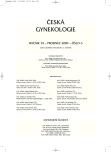Comparison of reactive oxygen species production in neat semen and washed spermatozoa
Authors:
M. Svobodová 1; I. Oborná 1; H. Fingerová 1; J. Novotný 2; J. Březinová 1; L. Radová 3; J. Vysloužilová 1; J. Horáková 1; J. Grohmannová 1
Authors‘ workplace:
Gynekologicko-porodnická klinika FN a LF UP Olomouc, přednosta doc. MUDr. R. Pilka, Ph. D.
1; Ústav biologie LF UP Olomouc, přednosta doc. RNDr. V. Divoký, Ph. D.
2; Laboratoř experimentální medicíny, LF UP Olomouc, přednosta doc. MUDr. M. Hajdúch, Ph. D.
3
Published in:
Ceska Gynekol 2009; 74(6): 399-403
Overview
Objective:
To determine Reactive Oxygen Species (ROS) production in neat semen and spermatozoa suspension using chemiluminescence and to examine correlation between both methods.
Subject:
Prospective laboratory study.
Setting:
Department of Obstetric and Gynecology, University Hospital, Olomouc.
Methods:
The study included fertile volunteers (FV, n = 17), men from infertile couples (NM, n = 19) and men with idiopathic infertility (NMI, n = 15). ROS levels were determined by the same method in neat and washed semen samples.
Results:
The ROS production in neat semen was lower than that in spermatozoa suspension. There was no significant diference in ROS production between volunteers and males from infertile couples. There was a significant correlation between log ROS in neat semen and in spermatozoa suspension in studied groups (FV r=0.85, p=1.5×10-5; NM r=0.76, p<2×10-4; NMI r=0.75, p<1.5×10-3).
Conclusions:
Measurement of ROS in neat semen is simpler, faster and better reflecting the actual level of oxidative stress than the same measurement in spermatozoa suspension. The implementation of this method can complement the algorithm of diagnostics and treatment of male infertility and be helpful in selection of patients for antioxidant or antibiotic treatment.
Key words:
oxidative stress, reactive oxygen species, neat semen, chemiluminescence.
Sources
1. Athayde, KS., Cocuzza, M., Agarwal, A., et al. Development of normal reference values for seminal reactive oxygen species and their correlation with leukocytes and semen parameters in a fertile population. J Androl, 2007, 28, p. 613-620.
2. Aitken, RJ., Clarkson JS. Significance of reactive oxygen species and antioxidants in defining the efficacy of sperm preparation techniques. J Androl, 1988, 9, p. 367-376.
3. Aitken, RJ., Ryan, AL., Baker, MA., et al. Redox activity associated with the maturation and capacitation of mammalian spermatozoa. Free Radic Biol Med, 2004, 36, p. 994-1010.
4. Aitken, RJ., De Iuliis, GN. Origins and consequences of DNA damage in male germ cells. Reprod Biomed Online, 2007, 14, p. 727-733.
5. Allamaneni, SSR., Agarwal, A., Nallella, KP., et al. Characterization of oxidative stress status by evaluation of reactive oxygen species levels in whole semen and isolated spermatozoa. Fertil Steril, 2005, 83, p. 800-803.
6. Aziz, N., Agarwal, A. Evaluation of sperm damage: beyond the World Health Organization criteria. Fertil Steril, 2008, 90, p. 484–485.
7. Cocuzza, M., Athayde, KS., Agarwal, A., et al. Age-related increase of reactive oxygen species in neat semen in healthy fertile men. Urology, 2008, 71, p. 490-494.
8. Desai, N., Sharma, R., Makker, K., et al. Physiologic and pathologic levels of reactive oxygen species in neat semen of infertile men. Fertil Steril, 2008, doi:10.1016/j.fertnstert. 2008.08.109.
9. Fingerová, H., Novotný, J., Barbořík, J., et al. Antioxidant capacity of seminal plasma measured by TAS Randox Biom Papers, 2007, 151, p. 37-40.
10. Labbe, C., Martoriati, A., Devaux, A., et al. Effects of sperm cryopreservation on sperm DNA stability and progeny development in rainbow trout. Mol Reprod Dev, 2001, 60, p. 397-404.
11. Moustafa, MH., Sharma, RK., Thornton, J., et al. Relationship between ROS production, apoptosis and DNA denaturation in spermatozoa from patients examined for infertility. Hum Reprod, 2004, 19, p. 129-138.
12. Novotný, J., Oborná, I., Březinová, J., et al. The occurrence of reactive oxygen species in semen of males from infertile couples. Biom Papers, 2003, 147, p. 173-176.
13. Oborná, I., Fingerová, H., Hajdúch, M., et al. Lykopen v terapii mužské neplodnosti. Čes Gynek, 2007, 72, s. 326-329.
14. Oborná, I., Fingerová, H., Novotný, J., et al. Oxidační stres v diagnostice a léčbě idiopatické mužské neplodnosti. Čes Gynek, 2008, 73, s. 356-360.
15. Oborná, I., Fingerová, H., Novotný, J., et al. Reactive oxygen species in human semen in relation to leukocyte contamination. Biom Papers, 2009, 153, p. 1-6.
16. Sharma, RK., Pasqualotto, FF., Nelson, DR., et al. The reactive oxygen species – total antioxidant capacity score is a new measure of oxidative stress to predict male infertility. Hum Reprod, 1999, 14, p. 2801-2807.
17. Shekarriz, M., Sharma, RK., Thomas, AJ., et al. Positive myeloperoxidase staining (Endtz test) as an indicator of excessive reactive oxygen species formation in semen. J Assist Reprod Genet, 1995, 12, p.70-74.
18. WHO laboratory manual for the examination of human semen and sperm-cervical mucus interaction. Cambridge: Cambridge University Press, UK, 1999.
Labels
Paediatric gynaecology Gynaecology and obstetrics Reproduction medicineArticle was published in
Czech Gynaecology

2009 Issue 6
Most read in this issue
- Amniotic fluid interleukin 6 levels in preterm premature rupture of membranes
- Prenatal intracranial hemorrhagie – diagnosis and follow-up
- Ovarian torsion in the first trimester gravidity after stimulation in vitro fertilization – case report
- Fertility preserving treatment of gynecological malignant tumors
